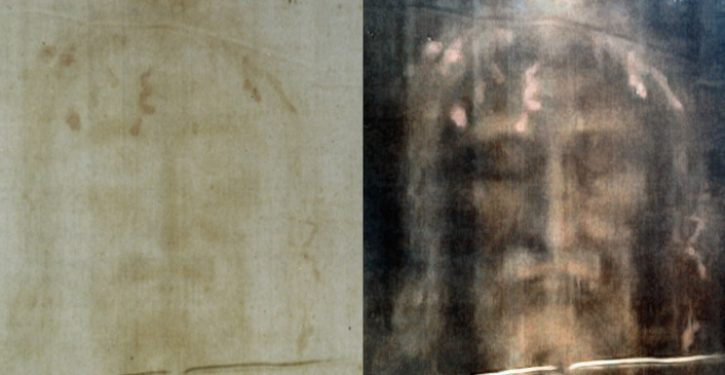
“Nothing is impossible with God.”
— (Luke 1:37)
With his comforting words to Mary, the angel Gabriel explains the miracle not only of Jesus’s conception but also of his resurrection, which we celebrate today. We who know the Risen Lord know that at Easter we commemorate the supreme event in all of human history, and so any physical proof we find of Christ’s resurrection demands our attention and awe. Countless Christians worldwide maintain that such proof exists: It is the Shroud of Turin, revered as the authentic burial cloth of Jesus Christ.
The earliest undisputed historical records place the Shroud in Lirey, France, between 1353 and 1357. Before that, according to various written sources, the Shroud traveled around the Middle East and Europe. It had once been in the possession of the Knights Templar, according to a researcher at the Vatican Secret Archives.
Since the 17th century, the sacred cloth has been housed in the Cathedral of Saint John the Baptist in Turin, Italy, except for a few years in the middle of the last century. Italian authorities knew that Hitler was had designs on the Shroud, so in 1939 it was secretly moved to an abbey, the Sanctuary of Montevergine, in southern Italy. The Nazis came within inches of finding it. Prayers from the Benedictine monks there diverted them. In 1946, the Shroud was returned to Turin, where it now resides in a heavily fortified underground vault.
Many in the secular media dismiss the Shroud as a “medieval forgery” or a clever hoax. That characterization is based largely on debunked carbon-14 tests. In 1988 they led researchers to estimate a date of origin between 1260 and 1390, but the samples tested came from edges that were added to fortify the cloth after it was damaged in a fire in 1532. Today we see lines caused by the fire. Heated silver in the Shroud’s storage box created distracting shapes that now border the man’s image.
Mark Antonacci, author of “Test the Shroud,” says that the 1988 tests have been contradicted by thousands of others. In their book “The Mystery of the Shroud” (2013), Giulio Fanti, a professor of mechanical engineering at the University of Padua, and Saverio Gaeta, an Italian journalist, describe chemical tests dating the relic to the first century a.d.
Moreover, the image on the Shroud is a photo-negative, as the Italian photographer Secondo Pia discovered in 1898. How would a medieval artist have created a perfect photo-negative image, given that photography was not invented until the early 19th century? By itself, this feature of the Shroud supports neither a medieval nor an ancient date of origin but rather reinforces the impression that, whenever or however the image was produced, the circumstances were remarkable.
Further mysteries abound. For example, the detailed image of the man rests only on the top two microfibers of the cloth, not penetrating the linen, as would paint or dye, and could be scraped away with a razor blade. The blood (type AB) seen on the cloth does fully penetrate the linen fibers, but tests show that it’s separate from, and underneath the image. “Blood first, image second,” is the catchphrase used by Shroud experts.
In an earlier article I explained that, using new technology, researchers have discovered that the Shroud contains “distance information” that enables the cloth to be read like a 3D map. Antonacci says that he and others have petitioned the Vatican to allow the Shroud to be tested at the atomic and subatomic levels. His hypothesis is that the Shroud was indeed a burial cloth and that the image on it was caused by “particle radiation emanating from the dead, crucified body” wrapped inside it.
The image on the cloth matches what we would expect not just for any man who had been crucified by Romans but specifically for Jesus, many details of whose crucifixion are exceptional. It was “contrary to normal Roman practices,” says Russ Breault, president of the Shroud of Turin Education Project. He elaborates:
Roman authorities wanted criminals to suffer on the cross and ultimately die of asphyxiation. That meant before crucifixion, criminals were either lightly flogged or not at all, so not to weaken them and hasten death. Pontius Pilate had Jesus beaten and flogged to the extreme hoping it would be punishment enough for his “blasphemy.” But John’s Gospel says the crowd demanded Christ’s crucifixion after his flogging. Later in the day when Jewish leaders asked Pilate to break the legs of the three men to hasten their death so that their bodies could be taken off the cross before the Sabbath, the Gospel states that Jesus was already dead. There was no need to break his legs, unlike [the case of] the two common thieves beside him.
No broken bones are evident on the Shroud, a finding consistent with the messianic prophecy in Psalms (34:19–20). “After 30 years of having studied and spoken about the miraculous Shroud, I know in my heart that the Shroud of Turin is a receipt from God,” Breault concludes, “a proof of purchase declaring our sin debt to be paid in full for those who believe.”
That the burial cloth of Jesus is still extant, lying in an underground vault in northwestern Italy, is astonishing. More so is that Jesus rose from the dead. Now add the further wonder that is the Shroud, which, if many of those who have studied closely are correct, is an image of Jesus at the moment of his resurrection.
Nothing is impossible with God.
Cross-posted at National Review Online


